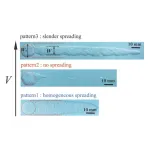To spread or slide? Scientists uncover how foams are spread on surfaces
Deciphering how soft materials are spread with a plate
2023-07-29
(Press-News.org)
Tokyo, Japan – Researchers from Tokyo Metropolitan University have uncovered the physics behind how foams are spread on surfaces. Balls of foam placed on a flat substrate were scraped across with a plate and observed. They identified different patterns which strongly depend on the scraping speed, governed by competing physical phenomena. Their findings apply to all kinds of soft materials that need to be spread evenly on surfaces, from mayonnaise on bread to insulation on walls.
Whether it be shaving foam, insulating foam in walls, or margarine on toast, the spreading of soft materials on flat surfaces is an important process, both from a practical, everyday point of view and the optimization of industrial processes. Yet surprisingly little is known about the spreading behavior of foams, particularly when it comes to how a flat blade or plate can scrape it across the surface into a layer.
This inspired researchers led by Professor Rei Kurita from Tokyo Metropolitan University to take a closer look at what’s going on. They created small domes of detergent foam on a flat surface and scraped them across with an acrylic plate, taking care to keep the distance between the plate and the surface fixed. The whole process was observed in depth with a video camera. Curiously, they discovered that the way in which the foam spreads changes completely when the speed of the plate is varied, and how much affinity the liquid in the foam has for the surface, i.e., whether it’s hydrophilic (attracts water) or hydrophobic (repels water).
On a hydrophobic surface, at low scraping speeds, the foam spreads evenly, creating a long section with the same width as the original dome. However, as the velocity is ramped up, the foam no longer spreads but coasts along the surface on a thin layer of fluid; the plate moves along leaving very little foam in its wake. Finally, at the highest speeds they tried, the spreading regime comes back, only now, the width of the tail of foam is thinner than the original dome. On the other hand, on a hydrophilic surface, there was no trace of the first regime.
The difference seen between the two surfaces led the team to focus on the effect of “wetting” i.e. whether the liquid in the foam likes to cover the surface. Focusing on the appearance of the low-speed regime, they found that on hydrophobic surfaces, films of detergent that make up the foam tend to anchor onto the surface since the liquid tends to “dewet”. The picture that emerges is one where the foam is simply progressively spread from the dome by the plate as it moves. However, if the foam is forced across fast enough to wet the surface, the foam now has a lubricating layer at the base. Walls in the foam, also known as Plateau borders, can no longer grab the substrate and lock itself into place. This is why a faster plate will leave a thin section of foam where the dome originally was, but push the rest across on a thin layer of liquid, leaving nothing but a trail of liquid. The investigation probed not only the plate speed, but also the effect of the gap width and how thick the plate is.
The team’s findings shed light on the lesser-known parts of an everyday phenomenon, with significant potential impact on not only foams, but a wider range of soft materials, whether it be paint, protective coatings, or mayonnaise.
This work was supported by JSPS KAKENHI Grant Numbers 20K14431, 17H02945 and 20H01874.
END
[Attachments] See images for this press release:

ELSE PRESS RELEASES FROM THIS DATE:
2023-07-29
Whether it’s setting up a Bank of England-type body to run it or fining patients for missing appointments, healthcare leaders, policymakers and practitioners past and present have a wealth of ideas about how they would change the NHS for the better.
Professor Dinesh Bhugra, a psychiatrist and former president of the British Medical Association and the Royal College of Psychologists, asked 14 peers, physicians and patients’ representatives for their prescription for the NHS.
The interviews are reproduced in Professor Bhugra’s new book, Conversations about the NHS. Thought-provoking and in some cases, controversial, ideas include:
Setting ...
2023-07-28
As with many toxins, exposure to the toxic metal cadmium during pregnancy can adversely impact fetal development. Now, researchers at the Rutgers School of Public Health think they’re beginning to understand how the metal inflicts its damage: by disrupting placental hormones that regulate pregnancy physiology.
Unlike other toxins, relatively little cadmium crosses the placenta to directly impact the fetus. Instead, the placenta concentrates cadmium in its tissue at rates of up to six times that found in umbilical cord serum.
“We already know a lot about cadmium and its detrimental impacts on fetal health, such ...
2023-07-28
A new study by scientists at the Jean Mayer USDA Human Nutrition Research Center on Aging (HNRCA) at Tufts University suggests that a micronutrient in human breast milk provides significant benefit to the developing brains of newborns, a finding that further illuminates the link between nutrition and brain health and could help improve infant formulas used in circumstances when breastfeeding isn’t possible.
The study, published July 11 in the Proceedings of the National Academy of Sciences (PNAS), also paves the way to study what role this micronutrient might play in the brain as ...
2023-07-28
Aurora, Colo. (July 28, 2023) – The Journal of Pediatrics has published a manuscript by Stacey Martiniano, MD, pulmonary specialist at Children’s Hospital Colorado and associate professor of pediatrics at the University of Colorado. Dr. Martiniano was primary author on the study titled, Late Diagnosis in the Era of Universal Newborn Screening Negatively Effects Short- and Long-Term Growth and Health Outcomes in Infants with Cystic Fibrosis. The manuscript’s senior author was Susanna McColley, MD, professor of pediatrics in pulmonary and sleep medicine at Northwestern University Feinberg ...
2023-07-28
The Royal Society of Chemistry has named Yi Hong, a distinguished university professor of bioengineering at The University of Texas at Arlington, as a fellow.
Hong said he was honored by the selection.
“Chemistry is amazing because it helps to create many new biomedical materials for human health and life saving,” Hong said. “This recognition encourages me not only to invent more creative biomaterials through chemical design for disease treatment, but also to be a role model to our next generation of scientists and engineers ...
2023-07-28
More than 15 years after the discovery of fast radio bursts (FRBs) – millisecond-long, deep-space cosmic explosions of electromagnetic radiation – astronomers worldwide have been combing the universe to uncover clues about how and why they form.
Nearly all FRBs identified have originated in deep space outside our Milky Way galaxy. That is until April 2020, when the first Galactic FRB, named FRB 20200428, was detected. This FRB was produced by a magnetar (SGR J1935+2154), a dense, city-sized neutron star with an incredibly powerful magnetic field.
This groundbreaking discovery led some to believe that FRBs identified at cosmological distances outside ...
2023-07-28
Myoung-Hwan Kim, an assistant professor in the Department of Physics and Astronomy at Texas Tech University, has been awarded a National Science Foundation grant in the field of materials research (DMR) related to quantum information science (QIS).
An emerging field of research, QIS involves studying the transmission of information through quantum mechanics principles. Kim’s research will examine the influence of magnetism and topology on quantum particles delivering information. Kin’s award is one of two Texas Tech recently received from the NSF for QIS research. The other was awarded to Lu Wei, an assistant professor in the Department of Computer ...
2023-07-28
Since the insulin pump started widespread use in the early 1980s, it’s become the option of choice for type 1 diabetes patients to manage their glucose levels in a way that doesn’t require testing their blood sugar and injecting insulin multiple times daily.
But now, a first-of-its kind study is looking at the issue of patients “running out of real estate” due to pump sites becoming fibrotic, irritated and less effective at delivering insulin. The UW Medicine-led study was published July 14 in the journal Diabetes Care, a publication of the American Diabetes Association.
“No ...
2023-07-28
Aurora, Colo. (July 28, 2023) – The Journal of Pediatrics has published a manuscript by Stacey Martiniano, MD, pulmonary specialist at Children’s Hospital Colorado and associate professor of pediatrics at the University of Colorado. Dr. Martiniano was primary author on the study titled, Late Diagnosis in the Era of Universal Newborn Screening Negatively Effects Short- and Long-Term Growth and Health Outcomes in Infants with Cystic Fibrosis. The manuscript’s senior author was Susanna McColley, MD, professor of pediatrics in pulmonary and sleep medicine at Northwestern University Feinberg School of Medicine and Ann & Robert H. Lurie Children's Hospital ...
2023-07-28
BOSTON - A new multi-center study led by doctors at Boston Medical Center and Columbia University found that having a genetic variant in the prealbumin gene alone is not sufficient for diagnosis of transthyretin amyloid cardiomyopathy in older Black patients. Published in the Journal of the American Heart Association, researchers discovered that a blood test that measures the transthyretin or prealbumin protein might also be helpful in diagnosing transthyretin amyloid cardiomyopathy and could be used to trigger more definitive imaging testing.
Transthyretin amyloid cardiomyopathy (ATTR‐CM) is an underdiagnosed cause of congestive heart failure among patients 60+ years of age. ...
LAST 30 PRESS RELEASES:
[Press-News.org] To spread or slide? Scientists uncover how foams are spread on surfaces
Deciphering how soft materials are spread with a plate




